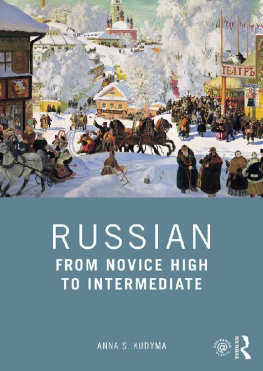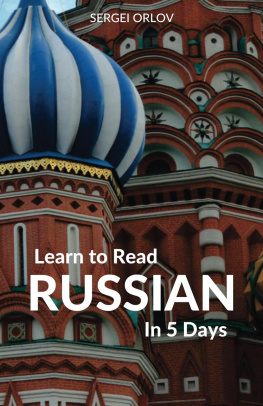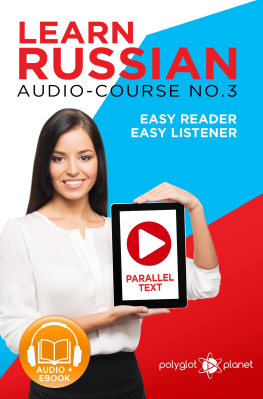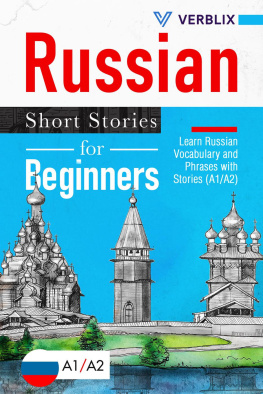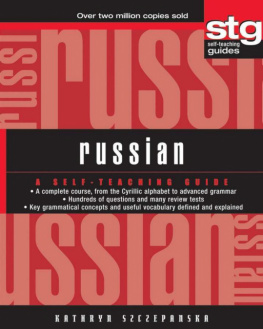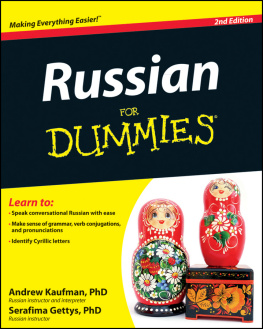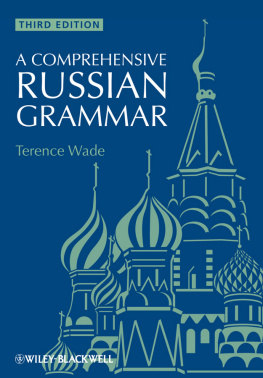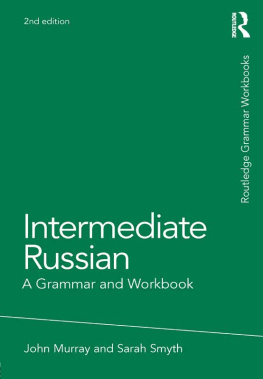Russian
Russian: From Novice High to Intermediate is a multi-level course that presents grammar, vocabulary, culture, music, film, and literature within the context of Russian life.
With a flexible modular approach structured around contemporary themes, this course builds on students reading, listening, speaking, and writing skills while also expanding their cultural literacy. Each chapter contains projects and scenarios that enable language learners to practice and demonstrate communicative competence. An interactive website full of videos, audio, and self-correcting exercises accompanies the course and can be accessed through www.routledge.com/9780367137137.
This comprehensive resource is ideal for use in second- and third-year Russian classes.
Anna S. Kudyma is Senior Lecturer in Russian and Ukrainian at the University of California Los Angeles. She holds an MA in Russian language pedagogy and a PhD in linguistics.
Russian
From Novice High to Intermediate
Anna S. Kudyma

First published 2022
by Routledge
2 Park Square, Milton Park, Abingdon, Oxon OX14 4RN
and by Routledge
Routledge is an imprint of the Taylor & Francis Group, an informa business
2022 Anna S. Kudyma
The right of Anna S. Kudyma to be identified as author of this work has been asserted by her in accordance with sections 77 and 78 of the Copyright, Designs and Patents Act 1988.
All rights reserved. No part of this book may be reprinted or reproduced or utilised in any form or by any electronic, mechanical, or other means, now known or hereafter invented, including photocopying and recording, or in any information storage or retrieval system, without permission in writing from the publishers.
Trademark notice: Product or corporate names may be trademarks or registered trademarks, and are used only for identification and explanation without intent to infringe.
British Library Cataloguing-in-Publication Data
A catalogue record for this book is available from the British Library
Library of Congress Cataloging-in-Publication Data
Names: Kudyma, Anna, author.
Title: Russian: from novice high to intermediate/Anna S. Kudyma.
Description: Abingdon, Oxon; New York, NY: Routledge, 2022. | Includes bibliographical references and index.
Identifiers: LCCN 2020051409 (print) | LCCN 2020051410 (ebook) | Subjects: LCSH: Russian language Textbooks for foreign speakers English.
Classification: LCC PG2129.E5 K84 2021 (print) | LCC PG2129.E5 (ebook) | DDC 491.782421 dc23
LC record available at https://lccn.loc.gov/2020051409
LC ebook record available at https://lccn.loc.gov/2020051410
ISBN: 978-0-367-13712-0 (hbk)
ISBN: 978-0-367-13713-7 (pbk)
ISBN: 978-0-429-02822-9 (ebk)
Typeset in Cambria
by Apex CoVantage, LLC
Access the companion website: www.routledge.com/9780367137137
I dedicate this textbook to the memory of my colleague, co-author, and friend Olga E. Kagan (19462018).
Contents
Guide
Russian: From Novice High to Intermediate is a textbook designed to help learners already familiar with basic morphological patterns and the standard beginners vocabulary to achieve intermediate proficiency in Russian in reading, listening, speaking, and writing. Students will also gain intercultural knowledge and competence that will not only facilitate communication with Russian speakers abroad but also make them receptive to daily interactions with a large variety of conversational partners. Gaining knowledge and understanding of other cultures is a foundational component in foreign language learning, as the Standards for Foreign Language Learning state.
. Byrd, D. (2011). An examination of culture knowledge: A study of L2 teachers and teacher educators beliefs and practices. Foreign Language Annals, 44 (1), 439.
Russian: From Novice High to Intermediate can be perfectly used as the main textbook for a second- and third-year Russian course. Along with the textbook, learners have access to an interactive website full of videos, audio, and self-correcting exercises (https://ccle.ucla.edu/course/view/russian-nov-to-int).
Russian: From Novice High to Intermediate includes 17 chapters structured around intermediate-level conversational themes and appropriate language functions typically required at oral proficiency interviews conducted according to ACTFL Standards. Each chapter contains projects and scenarios that enable language learners to practice and demonstrate communicative competence using the Russian language in a realistic but simulated way.
. ACTFL Proficiency Guidelines. Alexandria, VA: American Council on the Teaching of Foreign Languages.
. The World-Readiness Standards for Learning Languages (National Standards Collaborative Board, 2015)
Russian: From Novice High to Intermediate provides the following instructional materials, which are aligned with the ACTFL Proficiency Guidelines (2012) and the NCSSFL-ACTFL Can-Do Statements (2017):
)
- pronunciation and intonation review and practice;
- vocabulary development and word formation;
- a set of novice high and intermediate-level scenarios;
- various intermediate-level readings (magazine articles, infographics, blogs, forums, social media posts, emails, classifieds, commercials, recipes, menu, PSAs, weather forecasts, TV guides, biographies, short excerpts from Russian poetry, etc.) with assignments that help learners develop efficient reading skills;
- a set of listening assignments for authentic video clips (video blogs, advertisements, news reports, etc.) that are posted on the accompanying textbook website;
- various intermediate-level writing activities (blog posts and comments, Tweets, Facebook posts, WhatsApp messages, emails, advertisements, report writing, etc.). The writing tasks focus on developing both interpersonal and academic writing;
- cultural references that help build students intercultural competence;
- topics for class oral presentations;
- guidelines for individual and group projects;
- grammatical explanations and authentic (real-life) activities that integrate form, meaning, and content.
VOCABULARY
At the end of this course, students should have an active vocabulary of approximately 2000 words. The vocabulary is carefully selected to reflect learners need to express themselves and also understand texts for reading and listening on a large variety of topics at the intermediate level.
The selection of lexical items is based on the Russian Federation Lexical Minimums Country-specific vocabulary that allows students to discuss their own experiences in the American context has been included in the lexical items. The introduction of various means of word formation helps students expand their vocabulary as well.
. Andrushina, N. P. & Kozlova, T. V. (2000)... [The lexical minimum of Russian as a foreign language. Basic level. General proficiency]. St. Petersburg: Zlatoust.
GRAMMAR
The selection of grammar topics in each chapter is aligned with the practical needs of communication at the intermediate level. The grammar activities are contextualized around the topic covered in each chapter. The main points of Russian grammar are carefully selected for use at the novice high to intermediate levels of proficiency. Russian: From Novice High to Intermediate reviews basic Russian grammar points that present the most difficulty for active use and expands on them to allow students to increase their repertoire of spoken Russian as well as increase their comprehension of written and aural text. Certain grammar topics traditionally included in the second-year curriculum, such as participles and verbal adverbs, are introduced to establish receptive knowledge and prepare students for active production at the next stage of language learning.

